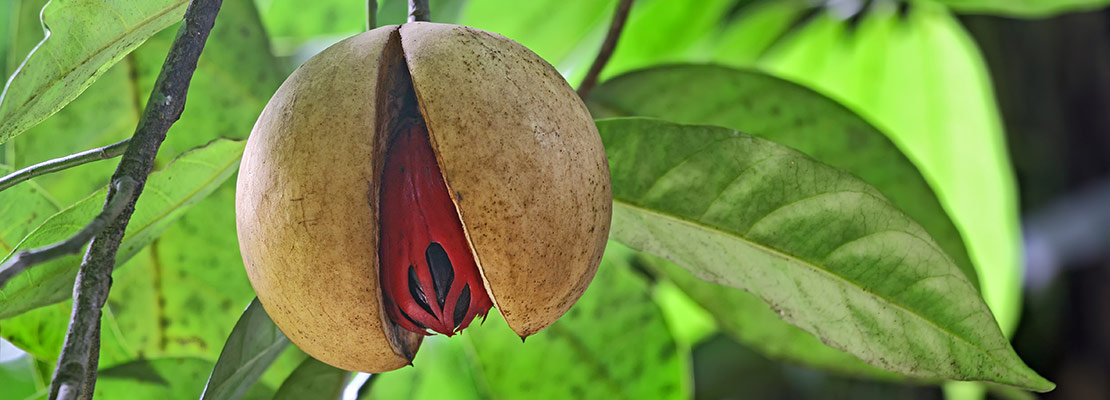Muskatnuss als Arzneimittel
Veröffentlicht am
Phytotherapie Ayurvedische Medizin
Der Muskatnussbaum (Myristica fragrans) ist ursprünglich auf den Maluku Inseln in Indonesien beheimatet, aber ebenfalls in Indien, Sri Lanka, Mauritius, Südafrika, Pakistan und den USA zu finden. Sein Samen (die Muskatnuss) und der Samenmantel (Macis) werden als Gewürze verwendet – in der Traditionellen Indischen und Pakistanischen Medizin ist die Muskatnuss allerdings auch als Heilmittel bekannt.
Doch wie sieht eigentlich die Studienlage zur pharmazeutischen Anwendung aus? Dieser Frage widmet sich die vorliegende Übersichtsarbeit. (1)
Ätherisches Öl
In den Studien, die sich mit der Muskatnuss befassen, kommt hauptsächlich Ätherisches Öl zum Einsatz, welches aus Macis, Blättern und Nuss gewonnen wird, während Rinde und Wurzeln bislang wenig Beachtung finden. Die chemischen Hauptbestandteile des Ätherischen Öls sind Sabinene, Eugenol, Myristicin, Caryophyllene, β-Myrcene, α-Pinene, β-Pinene, D-Limonene und 3-Carene.
Antioxidative Wirkung
Das aus der Nuss gewonnene ätherische Öl zeigte bei einer mittleren effektiven Konzentration von 181,4 µg/ml eine 88,7%-ige Hemmung der Oxidation von Linolsäure. (2) Die antioxidative Wirkung ließ sich außerdem abhängig von der Dosis steigern. (3)
Im DPPH-Test konnte eine signifikante Wirkung bei 1,35 mg/ml nach 20 Minuten Inkubationszeit beobachtet werden. (4) Von den Bestandteilen des Öls erwies sich dabei vor allem Elemicin, das vorrangig in dem Samen von Muskatnussbäumen aus Pakistan gefunden werden kann, als besonders antioxidativ. (5)
Die Heilkraft der Gewürze
32 Gewürzportraits und zahlreiche Rezepte – eine echte Medizin aus der Küche
32 Gewürzportraits und zahlreiche Rezepte – eine echte Medizin aus der Küche
Annette Kerckhoff · Dorothee Schimpf
ISBN: ISBN 978-3-945150-74-0
Erscheinungsjahr: 2017, 2. Aufl.
15,00 EUR
Zum Shop »Antimikrobielle Wirkung
Ätherisches Öl in 0,5%-iger Konzentration unterdrückte das Wachstum von E. faecalis und S. mutans. Um Pasteurella multocida am Wachstum zu hindern, reichte bereits eine 0,2%-ige Konzentration aus. (3) Ebenso wurde beobachtet, dass eine Dilution von 8-14 µg signifikant antibakteriell gegen E. coli, P. vulgaris, K. pneumoniae, S. aureus und B. subtilis wirkt. (6) In einer Minimalen Hemm-Konzentration von 1,6 µg/ml zeigte das ätherische Öl überdies eine potente Wirkung gegen S. typhimurium. (7)
Im Agardiffusionstest wurde mit ätherischem Öl aus der indonesischen Muskatnuss die höchste Wachstumshemmung bei einer Konzentration von 60% erreicht für S. aureus, S. epidermis, S. dysenteriae und S. typhi. (8) Eine Minimale Hemm-Konzentration von 1,2% und eine Minimale bakterizide Konzentration von 2,5% wirkte außerdem gegen Shigella sp. (9) Das Öl aus brasilianischer Muskatnuss hemmte das Wachstum von Colletotrichum gloesporioides (98%), C. musa (97%), F. semitectum (78%), Fusarium oxysporum (75%), Aspergillus niger (71%) und A. glaucus (60%). (10)
Darüber hinaus erwies sich das Ätherische Öl in einigen Arbeiten auch als Insektizid bzw. Nematizid. (11-16)
Weitere Effekte
Es gibt Hinweise aus Versuchen mit Ratten, dass Muskatnuss-Öl das Eindringen von Mikroorganismen in den Körper erschweren und die COX-2-Ausschüttung sowie den Gehalt an Substanz P im Blut reduzieren könnte. (17)
Eine Arbeit berichtet davon, dass eine Kombination aus ätherischen Ölen der Muskatnuss, Citronella und Benzoin Bluthochdruck signifikant reduzieren konnte. (18) Allerdings fehlen in dieser Studie wichtige Angaben zur Dosierung und Kontrolle.
Hervorzuheben ist ferner ein antiangiogenetischer Effekt, der sich bei einer Konzentration von 200 g/ml zeigte. (19) Antiangiogenese bedeutet wörtlich "gegen die Gefäßbildung". Es bezeichnet eine Methode, die Gefäßbildung bei Tumorerkrankungen einzudämmen und so deren Wachstum zu verlangsamen.
Fazit
Aufgrund ihrer antioxidativen und antimikrobiellen Wirkung verwundert es nicht, dass die Muskatnuss im Ayurveda z.B. bei Übelkeit, Durchfall, Cholera, Magenkrämpfen oder Parasiten zum Einsatz kommt. (20-21) Auch für den Einsatz in der Traditionellen Pakistanischen Medizin bei Bluthochdruck gibt es zumindest eine zarte Grundlage aus der Forschung. (22)
Die Autoren kritisieren allerdings, dass die meisten einbezogenen Studien wichtige Daten, etwa zu Kontrollgruppen, nicht liefern. Außerdem sind die Daten vornehmlich aus Experimenten mit Zellen oder Versuchen mit Tieren gewonnen worden – Studien mit Menschen sind kaum vorhanden. Zukünftige Forschung sollte sich daher auf diese Lücke konzentrieren und dabei Aspekte wie Toxizität, Bioverfügbarkeit und Pharmakokinetik untersuchen.
Literatur zu "Muskatnuss als Arzneimittel"
1) Ashokkumar K, Simal-Gandara J, Murugan M, Dhanya MK, Pandian A. Nutmeg (Myristica fragrans Houtt.) essential oil: A review on its composition, biological, and pharmacological activities. Phytother Res. 2022 Jul;36(7):2839-2851. doi: 10.1002/ptr.7491. Epub 2022 May 13. PMID: 35567294; PMCID: PMC9541156. Link
2) Piaru, S. P., Mahmud, R., Abdul Majid, A. M., & Mahmoud Nassar, Z. D. (2012). Antioxidant and antiangiogenic activities of the essential oils of Myristica fragrans and Morinda citrifolia. Asian Pacific Journal of Tropical Medicine, 5(4), 294–298. Link
3) Matulyte I, Jekabsone A, Jankauskaite L, Zavistanaviciute P, Sakiene V, Bartkiene E, Ruzauskas M, Kopustinskiene DM, Santini A, Bernatoniene J. The Essential Oil and Hydrolats from Myristica fragrans Seeds with Magnesium Aluminometasilicate as Excipient: Antioxidant, Antibacterial, and Anti-inflammatory Activity. Foods. 2020 Jan 2;9(1):37. doi: 10.3390/foods9010037. PMID: 31906495; PMCID: PMC7022514. Link
4) Vesna Nikolic, Ljubisa Nikolic, Ana Dinic, Ivana Gajic, Maja Urosevic, Ljiljana Stanojevic, Jelena Stanojevic & Bojana Danilovic (2021) Chemical Composition, Antioxidant and Antimicrobial Activity of Nutmeg (Myristica fragrans Houtt.) Seed Essential Oil, Journal of Essential Oil Bearing Plants, 24:2, 218-227, DOI: 10.1080/0972060X.2021.1907230. Link
5) Adiani, V., Gupta, S., Chatterjee, S. et al. Activity guided characterization of antioxidant components from essential oil of Nutmeg (Myristica fragrans). J Food Sci Technol 52, 221–230 (2015). doi: 10.1007/s13197-013-1034-7. Link
6) Soni R, Sharma G, Jasuja ND. Essential Oil Yield Pattern and Antibacterial and Insecticidal Activities of Trachyspermum ammi and Myristica fragrans. Scientifica (Cairo). 2016;2016:1428194. doi: 10.1155/2016/1428194. Epub 2016 Apr 12. PMID: 27190677; PMCID: PMC4844891. Link
7) Özkan, O. E. , Olgun, Ç. , Güney, B. , Gür, M. , Güney, K. , & Ateş, S. (2018). Chemical composition and antimicrobial activity of Myristica fragrans & Elettaria cardamomum essential oil. Kastamonu Uni., Orman Fakültesi Dergisi, 18(2), 225–229. Link
8) Nurjanah, S., Putri, I. L., & Sugiarti, D. P. (2017). Antibacterial Activity of Nutmeg Oil. KnE Life Sciences, 2(6), 563-569. doi: 10.18502/kls.v2i6.1076. Link
9) Ansory, H. M. , Fitriani, I. N. , & Nilawati, A. (2020). Chemical separation and antibacterial activity of nutmeg seed essential oil against Shigella sp. and Escherichia coli ATCC 25922. Materials Science and Engineering, 846, 012005. 10.1088/1757-899X/846/1/012005. Link
10) Valente, V. M. M. , Jham, G. N. , Dhingra, O. D. , & Ghiviriga, I. (2011). Composition and antifungal activity of the Brazilian Myristica fragrans Houtt essential oil. Journal of Food Safety, 31, 197–202. Link
11) Gotke, N. , Maheshwari, M. L. , & Mathur, V. K. (1990). Nematicidal activity of Myristica fragrans against Meloidogyne incognita . Indian Perfumer, 34(2), 105–107. Link
12) Huang, Y. , Tan, J. M. W. L. , Kini, R. M. , & Ho, S. H. (1997). Toxic and antifeedant action of nutmeg oil against Tribolium castaneum (Herbst) and Sitophilus zeamais Motsch. Journal of Stored Products Research, 33(4), 289–298. Link
13) Wagan, T. A. , Wang, W. , Hua, H. , & Cai, W. (2017). Chemical constituents and toxic, repellent, and oviposition‐deterrent effects of ethanol‐extracted Myristica fragrans (myristicaceae) oil on Bemisia tabaci (Hemiptera: Aleyrodidae). Florida Entomologist, 100(3), 594–601. Link
14) Kostic, I. , Petrovic, O. , Milanovic, S. , Popovic, Z. , Stankovic, S. , Todorovic, G. , & Kostic, M. (2013). Biological activity of essential oils of Athamanta haynaldii and Myristica fragrans to gypsy moth larvae. Industrial Crops and Products, 41, 17–20. Link
15) Adedire, C. (2002). Use of nutmeg Myristica fragrane (Houtt.) powder and oil for the control of cowpea storage bruchid, Callosobruchus maculatus Fabricius. Journal of Plant Diseases and Protection, 109(2), 193–199. Link
16) Cossetin LF, Santi EMT, Garlet QI, Matos AFIM, De Souza TP, Loebens L, Heinzmann BM, Monteiro SG. Comparing the efficacy of nutmeg essential oil and a chemical pesticide against Musca domestica and Chrysomya albiceps for selecting a new insecticide agent against synantropic vectors. Exp Parasitol. 2021 Jun;225:108104. doi: 10.1016/j.exppara.2021.108104. Epub 2021 Apr 1. PMID: 33812979. Link
17) Zhang WK, Tao SS, Li TT, Li YS, Li XJ, Tang HB, Cong RH, Ma FL, Wan CJ. Nutmeg oil alleviates chronic inflammatory pain through inhibition of COX-2 expression and substance P release in vivo. Food Nutr Res. 2016 Apr 26;60:30849. doi: 10.3402/fnr.v60.30849. PMID: 27121041; PMCID: PMC4848392. Link
18) Kholibrina, C. R. , & Aswandi, A. (2021). The aromatherapy formulation of essential oils in reducing stress and blood pressure on human. IOP Conference Series: Earth and Environmental Science, 914, 012072. 10.1088/1755-1315/914/1/012072. Link
19) Al‐Rawi, S. S. , Ibrahim, A. H. , Abdur Rahman, N. N. N. , Nama, M. M. B. , Majid, A. M. S. A. , & Kadir, M. O. (2011). The effect of supercritical fluid extraction parameters on the nutmeg oil extraction and its cytotoxic and antiangiogenic properties. Procedia Food Science, 1, 1946–1952. Link
20) Van Gils C, Cox PA. Ethnobotany of nutmeg in the Spice Islands. J Ethnopharmacol. 1994 Apr;42(2):117-24. doi: 10.1016/0378-8741(94)90105-8. PMID: 8072304. Link
21) Ziyatdinova, G. , Ziganshina, E. , Cong, P. N. , & Budnikov, H. (2016). Ultrasound‐assisted micellar extraction of phenolic antioxidants from spices and antioxidant properties of the extracts based on coulometric titration data. Analytical Methods, 8, 7150–7157. Link
22) Malik K, Ahmad M, Bussmann RW, Tariq A, Ullah R, Alqahtani AS, Shahat AA, Rashid N, Zafar M, Sultana S, Shah SN. Ethnobotany of Anti-hypertensive Plants Used in Northern Pakistan. Front Pharmacol. 2018 Jul 24;9:789. doi: 10.3389/fphar.2018.00789. PMID: 30087613; PMCID: PMC6066661. Link



